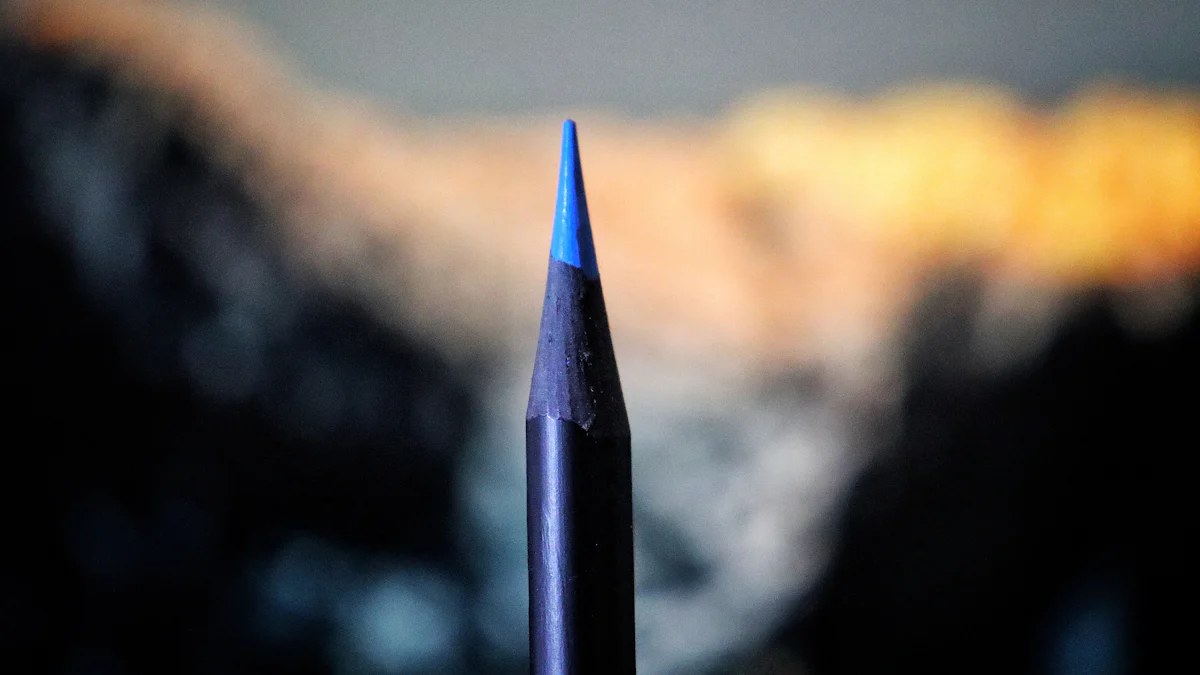
Graphite coatings play a pivotal role in enhancing the performance and durability of components across various industries. These coatings come in several types, each offering unique benefits. The main types include:
- Thermal Spray: Known for its application in high-temperature environments.
- Plasma Spray: Offers excellent adhesion and wear resistance.
- Nickel-Graphite: Provides superior corrosion resistance.
- Pyrolytic Carbon: Ensures high purity and conductivity.
- TaC-coated Graphite: Delivers exceptional oxidation protection.
The demand for graphite coatings continues to rise, driven by their excellent lubrication, corrosion resistance, and thermal conductivity properties. Industries such as automotive and aerospace significantly benefit from these coatings, contributing to market growth.
Key Takeaways
- Graphite coatings enhance durability and performance across various industries, making them essential for applications in automotive, aerospace, and electronics.
- Different types of graphite coatings, such as thermal spray and plasma spray, offer unique benefits like high-temperature resistance and excellent adhesion, catering to specific industry needs.
- Nickel-graphite coatings provide superior corrosion resistance, particularly in marine environments, ensuring the longevity of equipment exposed to harsh conditions.
- Pyrolytic carbon coatings are ideal for high-purity applications, such as semiconductor manufacturing, due to their exceptional conductivity and contamination-free properties.
- The growing demand for graphite coatings is driven by their ability to improve thermal management and reduce wear, leading to cost savings and enhanced operational efficiency.
- Future developments in graphite coatings focus on sustainable practices and innovative application techniques, promising to expand their use in advanced industries.
- By adopting eco-friendly materials and energy-efficient production methods, the graphite coatings industry is moving towards a more sustainable future.
Types of Graphite Coatings

Thermal Spray Coatings
Thermal spray coatings represent a versatile solution in the realm of graphite coatings. These coatings involve the application of molten or semi-molten materials onto a surface to create a protective layer.
Applications in Aerospace
In the aerospace industry, thermal spray coatings find extensive use due to their ability to withstand extreme temperatures and harsh environments. They enhance the durability of components such as turbine blades and engine parts, ensuring optimal performance and longevity. The aerospace sector relies on these coatings to maintain the integrity of critical components, thereby reducing maintenance costs and improving safety.
Benefits in Automotive Industry
The automotive industry benefits significantly from thermal spray coatings. These coatings provide excellent wear resistance, which is crucial for engine components and other high-friction areas. By reducing wear and tear, thermal spray coatings contribute to the overall efficiency and lifespan of vehicles. Additionally, they offer thermal management solutions, helping to dissipate heat effectively and maintain optimal operating conditions.
Plasma Spray Coatings
Plasma spray coatings utilize a high-temperature plasma jet to melt and propel coating materials onto a substrate. This method ensures strong adhesion and a uniform coating layer.
Uses in Electronics
In the electronics industry, plasma spray coatings play a vital role in enhancing the performance of electronic components. They provide excellent electrical conductivity, making them ideal for circuit boards and other conductive applications. These coatings also offer protection against electromagnetic interference (EMI), ensuring the reliability and efficiency of electronic devices.
Advantages in Industrial Machinery
Industrial machinery benefits from plasma spray coatings due to their superior wear resistance and corrosion protection. These coatings extend the lifespan of machinery components, reducing downtime and maintenance costs. By providing a robust barrier against harsh environmental conditions, plasma spray coatings enhance the overall efficiency and productivity of industrial operations.
Nickel-Graphite Coatings
Nickel-graphite coatings combine the properties of nickel and graphite to deliver exceptional performance in various applications.
Corrosion Resistance in Marine Applications
In marine environments, nickel-graphite coatings offer outstanding corrosion resistance. They protect metal surfaces from the corrosive effects of saltwater and other harsh elements, ensuring the longevity and reliability of marine equipment. These coatings are essential for maintaining the structural integrity of ships, offshore platforms, and other marine structures.
Conductivity in Electrical Components
Nickel-graphite coatings provide excellent electrical conductivity, making them ideal for use in electrical components. They enhance the performance of connectors, switches, and other conductive parts, ensuring efficient power transmission and reducing energy loss. The combination of nickel’s durability and graphite’s conductivity makes these coatings a preferred choice in the electronics industry.
Pyrolytic Carbon Coatings
Pyrolytic carbon coatings stand out for their high purity and exceptional conductivity. These coatings are created through a chemical vapor deposition process, which results in a smooth, dense, and low-porosity surface. This unique structure makes them ideal for applications requiring high-purity environments.
High-Purity Applications
Industries such as semiconductor manufacturing and medical devices rely heavily on pyrolytic carbon coatings. In semiconductor production, these coatings provide a contamination-free environment, crucial for maintaining the integrity of sensitive components. Medical devices benefit from the biocompatibility and non-reactive nature of pyrolytic carbon, making it suitable for implants and other critical applications.
Conductive Coating Benefits
The conductive properties of pyrolytic carbon coatings make them invaluable in electronics. They enhance the performance of components by providing efficient pathways for electrical currents. This conductivity is essential for devices like cellphones, tablets, and computers, where reliable electrical performance is paramount. Additionally, these coatings offer protection against electromagnetic interference, ensuring device reliability.
TaC-coated Graphite
TaC-coated graphite combines the benefits of tantalum carbide with graphite, resulting in a coating that excels in high-temperature environments. This combination provides a robust solution for industries facing extreme conditions.
High-Temperature Resistance
TaC-coated graphite is renowned for its ability to withstand high temperatures. Industries such as aerospace and energy production utilize these coatings to protect components exposed to intense heat. Turbine blades and furnace linings benefit from the thermal stability provided by TaC coatings, ensuring long-term performance and safety.
Oxidation Protection
In addition to temperature resistance, TaC-coated graphite offers superior oxidation protection. This feature is critical in environments where components are exposed to oxygen at elevated temperatures. By preventing oxidation, these coatings extend the lifespan of parts, reducing maintenance needs and operational costs.
Applications of Graphite Coatings

Aerospace Industry
Thermal Protection
Graphite coatings provide essential thermal protection in the aerospace industry. These coatings shield components from extreme temperatures encountered during flight. Turbine blades and engine parts benefit significantly from this protection, ensuring they maintain structural integrity and performance. The high-temperature resistance of graphite coatings reduces the risk of thermal degradation, which is crucial for the safety and efficiency of aerospace operations.
Lubrication in High-Temperature Environments
In high-temperature environments, graphite coatings offer superior lubrication. They reduce friction between moving parts, minimizing wear and tear. This lubrication is vital for components such as bearings and gears, which operate under intense heat. By maintaining smooth operation, graphite coatings enhance the longevity and reliability of aerospace machinery, contributing to reduced maintenance costs and improved operational efficiency.
Automotive Industry
Engine Component Coatings
Graphite coatings play a pivotal role in the automotive industry, particularly for engine components. These coatings provide a protective barrier against wear and corrosion, extending the lifespan of critical parts. Engine pistons, cylinders, and valves benefit from the enhanced durability offered by graphite coatings. This protection ensures optimal engine performance and efficiency, reducing the need for frequent repairs and replacements.
Wear Resistance
The wear resistance provided by graphite coatings is invaluable in the automotive sector. Components subjected to high friction, such as brake pads and clutches, experience less wear and tear. This resistance enhances the overall durability of vehicles, leading to longer service intervals and lower maintenance costs. By preserving the integrity of automotive parts, graphite coatings contribute to safer and more reliable vehicles.
Electronics Industry
Conductive Coatings for Circuit Boards
In the electronics industry, graphite coatings serve as conductive coatings for circuit boards. These coatings ensure efficient electrical conductivity, which is essential for the performance of electronic devices. By providing a reliable pathway for electrical currents, graphite coatings enhance the functionality of circuit boards. This conductivity is crucial for devices like smartphones, computers, and other electronic gadgets, where precision and performance are paramount.
Heat Dissipation Solutions
Graphite coatings offer effective heat dissipation solutions in electronic applications. They help manage the heat generated by electronic components, preventing overheating and potential damage. This thermal management is vital for maintaining the performance and longevity of electronic devices. By dissipating heat efficiently, graphite coatings ensure that electronic components operate within safe temperature ranges, enhancing their reliability and lifespan.
Benefits of Graphite Coatings
Graphite coatings offer numerous advantages that significantly enhance the performance and durability of components across various industries. These benefits make them a preferred choice in sectors such as automotive, aerospace, and electronics.
Enhanced Durability
Graphite coatings provide exceptional durability, making them ideal for applications where wear and tear are prevalent.
Resistance to Wear and Tear
Graphite coatings excel in resisting wear and tear, which is crucial for components exposed to high friction and mechanical stress. In industries like automotive and aerospace, where components endure constant movement and pressure, graphite coatings ensure longevity and reliability. This resistance reduces the frequency of maintenance and replacement, leading to cost savings and improved operational efficiency.
Longevity in Harsh Conditions
The ability of graphite coatings to withstand harsh environmental conditions further enhances their durability. They protect components from corrosion, oxidation, and extreme temperatures, ensuring long-term performance. Industries such as marine and industrial machinery benefit from this longevity, as components remain functional and efficient even in challenging environments.
Improved Performance
Graphite coatings not only enhance durability but also improve the overall performance of components through superior thermal and electrical properties.
Thermal Management
Graphite coatings offer excellent thermal management capabilities, which are essential in industries where heat dissipation is critical. In the electronics sector, these coatings help manage the heat generated by electronic components, preventing overheating and potential damage. This thermal regulation ensures that devices operate within safe temperature ranges, enhancing their reliability and lifespan.
Electrical Conductivity
The electrical conductivity of graphite coatings makes them invaluable in applications requiring efficient power transmission. In the automotive and electronics industries, these coatings enhance the performance of electrical components by providing reliable pathways for electrical currents. This conductivity reduces energy loss and improves the efficiency of devices, contributing to better overall performance.
Graphite coatings continue to gain popularity due to their ability to enhance durability and performance across various applications. Their unique properties make them indispensable in industries that demand high-quality, reliable solutions.
Future Developments in Graphite Coatings
Innovations in Coating Technologies
The landscape of graphite coatings is evolving with remarkable innovations in coating technologies. These advancements aim to enhance the performance and applicability of coatings across various industries.
Emerging Techniques in Coating Application
Emerging techniques in coating application are revolutionizing the way industries utilize graphite coatings. Researchers and engineers are developing methods that improve the adhesion, uniformity, and efficiency of coatings. Techniques such as advanced thermal spraying and chemical vapor deposition are gaining traction. These methods allow for precise control over coating thickness and composition, resulting in superior performance characteristics. Industries benefit from these innovations by achieving better protection and functionality in their components.
Potential New Applications in Advanced Industries
The potential for new applications in advanced industries is vast. As technology progresses, industries such as aerospace, electronics, and energy are exploring novel uses for graphite coatings. In aerospace, coatings are being developed to withstand even higher temperatures and more corrosive environments. The electronics industry is leveraging the electrical conductivity of graphite coatings to enhance the performance of next-generation devices. Energy sectors are investigating coatings that improve the efficiency and longevity of renewable energy systems. These advancements promise to expand the reach and impact of graphite coatings in cutting-edge fields.
Environmental Considerations
As the demand for graphite coatings grows, so does the need for sustainable practices and eco-friendly materials. Environmental considerations are becoming a crucial aspect of coating production and application.
Sustainable Practices in Coating Production
Sustainable practices in coating production focus on reducing the environmental footprint of manufacturing processes. Companies are adopting energy-efficient technologies and minimizing waste generation. The use of water-based and low-VOC (volatile organic compounds) formulations is becoming more prevalent. These practices not only reduce environmental impact but also align with regulatory standards and consumer expectations. By prioritizing sustainability, manufacturers contribute to a greener future while maintaining the quality and effectiveness of their coatings.
Eco-Friendly Materials for Graphite Coatings
The development of eco-friendly materials for graphite coatings is a key area of focus. Researchers are exploring alternatives to traditional materials that offer similar or enhanced properties without harmful environmental effects. Bio-based binders and renewable raw materials are being integrated into coating formulations. These innovations aim to reduce reliance on non-renewable resources and decrease the carbon footprint of coating production. By embracing eco-friendly materials, the industry can meet the growing demand for sustainable solutions while ensuring the continued advancement of graphite coatings.
Graphite coatings offer significant benefits, enhancing both durability and performance across various industries. These coatings provide exceptional wear resistance and thermal management, making them indispensable in sectors like aerospace, automotive, and electronics. The market for graphite coatings continues to grow, driven by technological advancements and the increasing demand for high-performance solutions. Companies invest in research and development to create innovative coatings that meet evolving industry needs. As the focus shifts towards environmentally friendly practices, the potential for future advancements and applications in graphite coatings remains promising.
FAQ
What are the primary benefits of graphite coatings?
Graphite coatings offer several advantages, including enhanced durability, excellent thermal and electrical conductivity, and superior corrosion resistance. These properties make them ideal for applications in industries such as automotive, aerospace, and electronics, where high-performance materials are essential.
How do graphite coatings improve thermal management?
Graphite coatings excel in thermal management by efficiently dissipating heat. This capability is crucial in electronics and automotive industries, where components generate significant heat. By managing temperature effectively, graphite coatings help maintain optimal operating conditions and prevent overheating.
Why are graphite coatings popular in the automotive industry?
The automotive industry values graphite coatings for their ability to reduce wear and tear, enhance durability, and improve efficiency. These coatings protect engine components and other high-friction areas, leading to longer service intervals and reduced maintenance costs.
Can graphite coatings be used in marine environments?
Yes, graphite coatings are suitable for marine applications due to their excellent corrosion resistance. They protect metal surfaces from the corrosive effects of saltwater and other harsh elements, ensuring the longevity and reliability of marine equipment and structures.
What role do graphite coatings play in the electronics industry?
In the electronics industry, graphite coatings serve as conductive coatings for circuit boards and other components. They provide efficient electrical conductivity and protection against electromagnetic interference, enhancing the performance and reliability of electronic devices.
Are there environmental considerations in the production of graphite coatings?
Manufacturers are increasingly adopting sustainable practices in the production of graphite coatings. This includes using eco-friendly materials and energy-efficient technologies to minimize environmental impact while maintaining the quality and effectiveness of the coatings.
How do graphite coatings enhance the performance of aerospace components?
Graphite coatings provide thermal protection and lubrication in high-temperature environments, which are common in aerospace applications. They reduce friction and wear on components like turbine blades and engine parts, ensuring structural integrity and optimal performance.
What future developments are expected in graphite coating technologies?
The future of graphite coatings includes innovations in application techniques and the development of eco-friendly materials. Emerging methods like advanced thermal spraying and chemical vapor deposition promise improved adhesion and performance, while sustainable materials aim to reduce environmental impact.
How do graphite coatings compare to other types of coatings?
Graphite coatings offer unique benefits such as superior thermal and electrical conductivity, making them a preferred choice over other coatings in specific applications. Their ability to withstand harsh conditions and provide long-lasting protection sets them apart in industries requiring high-performance solutions.
What industries benefit most from graphite coatings?
Industries such as automotive, aerospace, electronics, marine, and energy benefit significantly from graphite coatings. These coatings enhance durability, reduce wear, and improve efficiency, making them indispensable in sectors that demand reliable and high-quality materials.